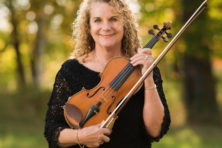Door to Nature
- Share
- Tweet
- Pin
- Share
Even though every month is a potentially good bird month for many people, March is extra special in signaling the return of some species which nested here last year, wintered in the South and are now returning to breed. Some of the typical harbingers of spring include the Red-winged Blackbird, Common Grackle, Eastern Meadowlark, Horned Lark, American Robin, Song Sparrow and American Kestrel. Invariably the earlier-than-usual February report of a robin is a bird that wintered here, something which frequently occurs.
A bird’s return to Door County that we long for more than any other is the Eastern Bluebird. Recent years have had some here by the second week of March, nearly always by the third week. Bear in mind that bluebirds don’t winter any further south than they absolutely have to. They are showing up fairly regularly on Christmas bird counts in southern counties of Wisconsin. Several successfully wintered in the Ephraim and Fish Creek areas in recent years, and this winter there have been sightings of them as far north as the U.P. of Michigan. Two wild foods which appear to have been sustaining them during their precarious cold weather survival have been the fruits of Common Juniper shrubs and dried wild grapes.
I’ve been building many bluebird nest boxes in recent years and we’ve been carefully placing them out and monitoring them, constantly learning more and more of the habits about these special birds. Usually they have begun nest building by mid-April with much depending upon the amount of snow cover remaining, air temperature, and availability of insects. Even though a warm spell of weather may trigger very early egg laying and hatching, unseasonably late cold weather and even some snowstorms often present insurmountable problems for the bluebird families. Not only do the four or five hungry nestlings have to be fed, but the adults obviously also need nourishment, and they usually come first.
Cold wet weather does not favor an increase in insect populations which, in turn, fairly often leads to the starvation of the young. Even the adult birds, after the clutch of eggs has been laid, will struggle to find food for themselves while the unhatched eggs get colder and colder. Here is where regular monitoring of each of one’s nest boxes becomes very critical, at least once weekly or even more often in the early part of a challenging spring.
Once a complete clutch of eggs has been laid, one of the adults should be expected to fly from the nest at your approach to monitor. If they don’t, day after day, and if the eggs are very cold to your touch every time you check the nest over a minimum of a two-week period, then the proper thing to do is to remove and destroy the clutch of cold eggs, thereby enabling the adult pair to re-nest, which invariably they will do. This is only one case where good monitoring of bluebird nest boxes is absolutely vital to the birds’ continued success in raising healthy young. Our emphatic suggestion is this: In case you or someone else will not properly monitor the nest boxes you erect, then it is better that you do not purchase or build and place out the boxes in the first place. Simply stated, bluebirds need people!
Forty of the 41 bluebird boxes on our trail are the Kentucky (K-style) box. The phenomenal success we’ve had with the K-style boxes has been due to the style and manner of erecting them and to our choice of sites. This is downright critical to successful nesting. As has been mentioned previously, extremely cold weather during early nesting can present several problems. Facing the box entrances in an easterly direction when possible means that early morning sunshine will fall on the front of the box, through the entrance opening, and help to warm the interior, an especially important point if an adult and eggs or young are inside and in need of extra critical warmth.
A truly outstanding organization to which we belong is, “Bluebird Restoration Association of Wisconsin” (BRAW). Their membership address is: BRAW, 5221 Cheryl’s Dr., Plover, WI 54467, and their website is outstanding: http://www.braw.org. This very active group includes many people from throughout the state who are dedicated to steadily increasing the Eastern Bluebird population of Wisconsin and elsewhere. Various styles of nest boxes with experimental modifications and methods of their placement have been tried, meticulous records kept and continuous communication maintained among members.
We’ve favored the K-style box because it is easy to build and erect, simple to monitor and also to clean out once each brood of nestlings has fledged. This spring I will be building my newly designed K-style boxes having both a top opening for easy and proper monitoring and also a side opening for the easiest and most thorough cleaning. Send me $2 for a complete set of my revised K-style box plans plus other helpful hints in placement of boxes and caring for them. My address is: 3962 Hillside Rd., Egg Harbor, WI 54209.
Charlotte and I will be conducting a free bluebird workshop and learning session at the Crossroads Nature Center in Sturgeon Bay on Wednesday, April 2 at 7 P.M. We personally believe that Door County bluebird habitats are very good and abundant and that there exist a large number of outstanding “untapped” bluebird trail sites. Please consider helping Wisconsin become the number one bluebird state in the U.S. Something blue “up there” will thank you!





